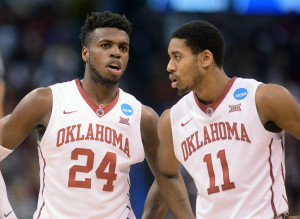
By PAUL GOTHAM
HOUSTON, TX. — University of Oklahoma Sooners coach Lon Kruger knows his team shoots the three as well as any in the country. Kruger realizes, too, his defense is playing its best at the right time. More importantly, the fifth-year coach understands his team’s success has to do with 105.
When Oklahoma takes the court against Villanova Saturday in the Final Four it will be another in a long line of consecutive starts for seniors Isaiah Cousins (13 ppg/3.4 apg), Buddy Hield (25.4 ppg/5.7 rpg) and Ryan Spangler (10.3 ppg/9.2 rpg). A streak of consistency starting when the trio were sophomores.
“We knew we had good-character guys in the recruiting process,” Kruger said Thursday. “We knew they were from programs where expectations were high, the work ethic was good.”
Still, Kruger could not have predicted this level of consistency. He credited his staff for bringing together a class from Mount Vernon, New York, Freeport, Bahamas and Bridge Creek, Oklahoma.
“It’s a special job what our assistant coaches did back then to know that people were going to be able to mesh together like this,” Kruger added. “I don’t know if anyone could have projected this, 105 or whatever consecutive starts from a health standpoint.”
As freshmen, they were part of an OU team which finished 20-12 but exited the NCAA Tournament after just one game. A year later, the Sooners again played just one game in the big dance. This time though Cousins, Hield and Spangler all started, and Jordan Woodard (13 ppg) joined the lineup. A year ago, their season ended with a defeat to Michigan State in the Sweet Sixteen. Twelve months later, with the majority of their staring lineup intact, the Sooners have reached the Final Four for the first time in more than a decade.
“Those backgrounds are all different,” Kruger stated. “For those backgrounds to mesh together would have been hard to project. But they’ve done a remarkable job and appreciate each other very much.”
Hield’s impact, from a numbers standpoint, upon the Sooners is undeniable. The 6-4 senior guard joins the likes of Larry Bird, Glen Rice and Dennis Scott as the only players in NCAA history to average 25 points a game and lead their team to the Final Four.
He has gone from shooting 23.8 percent (19-80) from behind the 3-point arc and scoring 7.8 points in 25 minutes a game as a freshman to hitting 46.5 percent (146-314) from long range this season.
“The guys recognize Buddy is at the core of everything we do,” Kruger explained. “Buddy’s going to get that target on his back. I think the other guys, number one, they recognize what Buddy has done as being very special and they’re comfortable with that. They also recognize, too, when defenses make it tough on Buddy, they’ve got to be able to step up and take advantage of additional opportunities. I’ve been really impressed with their maturity as a group in how well they have handled that.:
The role Cousins has played can’t be overlooked.
“Obviously Isaiah makes a lot of plays for Buddy, gets him the ball,” Kruger noted. “Being that big point guard that can explode out of the backcourt, push the pace, push the tempo, get into the paint, keep people honest in transition, but also step out and make threes. He’s had a big impact on us.”
Just as important is the position adjustment Cousins made.
“He played point a little bit as a freshman, more the wing in his sophomore and junior year,” Kruger explained. “Now to move back to the point again, that really freed up Jordan Woodard to move over to the wing and shoot the ball extremely well and make plays from there.”
Spangler’s contributions were evident last weekend when the Sooners defeated Texas A&M and Oregon to advance.
“Ryan is a special guy,” Kruger commented. “From a defensive standpoint, he’s got great anticipation, great awareness, good feel. He can move out, he’s not going to steal the ball from perimeter guys, but he can keep them in front of him, take good angles, he’s got a good feel for it.
“Defensively in Anaheim last week, we had a couple stretches in the first half, both the Texas A&M game and the Oregon game, where we were pretty good in terms of being able to create a margin. We were able to get stops for six or eight minutes, didn’t score at the other end. It’s hard to get a margin if you’re trading buckets. I thought defensively that’s where all that started. Like where we’re at defensively right now. We’re better than we’ve been all year.”
OU enters Saturday’s game second in the nation hitting 42.8 percent (376-879) from behind the arc. Their 10.4 triples a game are sixth in the country.
“We’re a club that needs to shoot it well,” Kruger said. “We’re a club that needs to get in transition, have some pace to the ballgame, create off the dribble for one another. Obviously, making threes is a big part of all of that.”
Oklahoma beat Villanova, 78-55 when the two teams met in early December.
“If you only followed Buddy Hield or Oklahoma, you’d just think this guy is Superman,” Villanova coach Jay Wright said. “The other thing you would think is that the other guys aren’t as good.
“We know how good he is, but we’ve been on the floor with him. But we also know how good all the other guys are because the other guys hurt us in that game…Our guys know. I think our guys have a different perspective on this Oklahoma team than maybe the national fan base that just watched Buddy put up big numbers.”

Leave a Reply